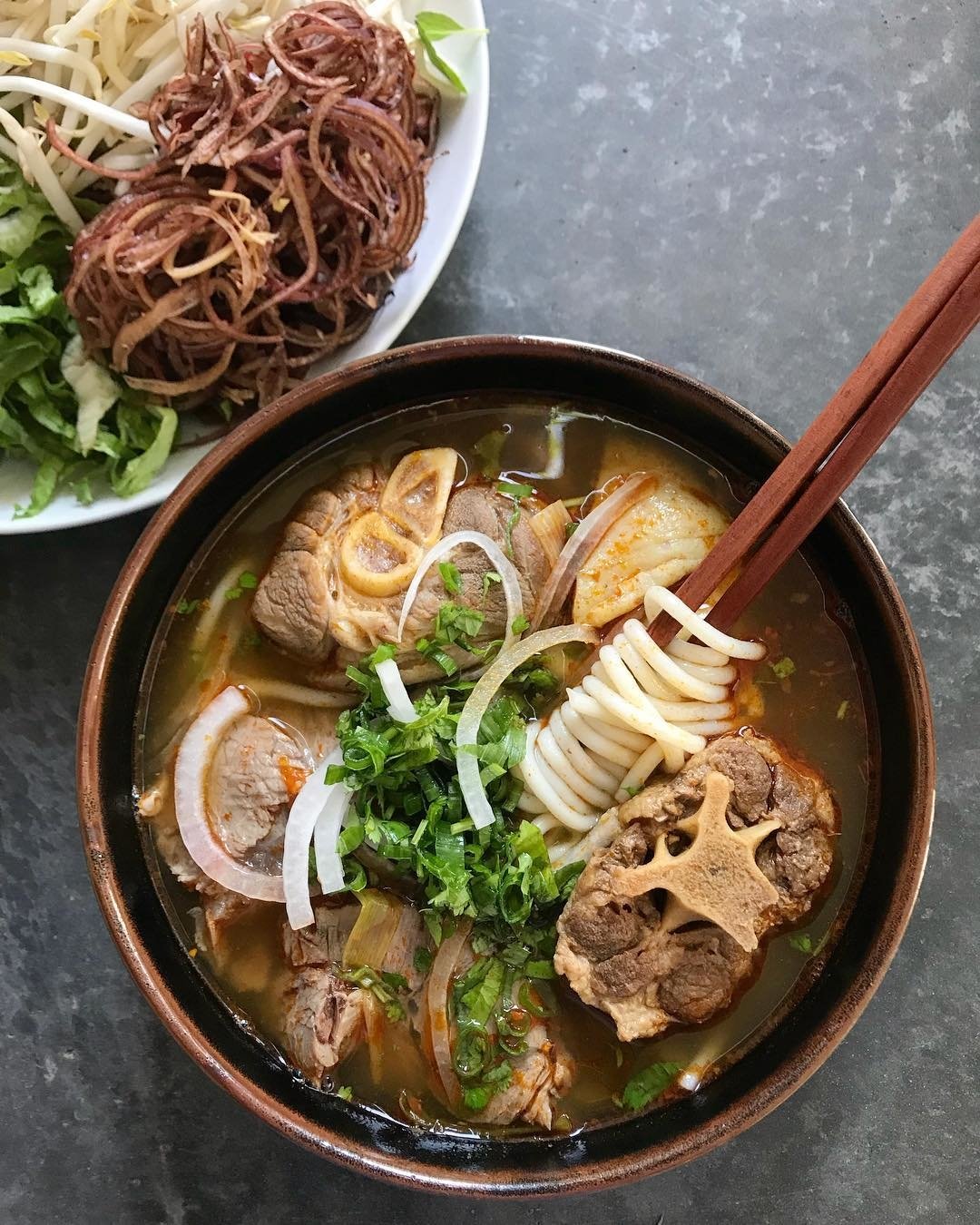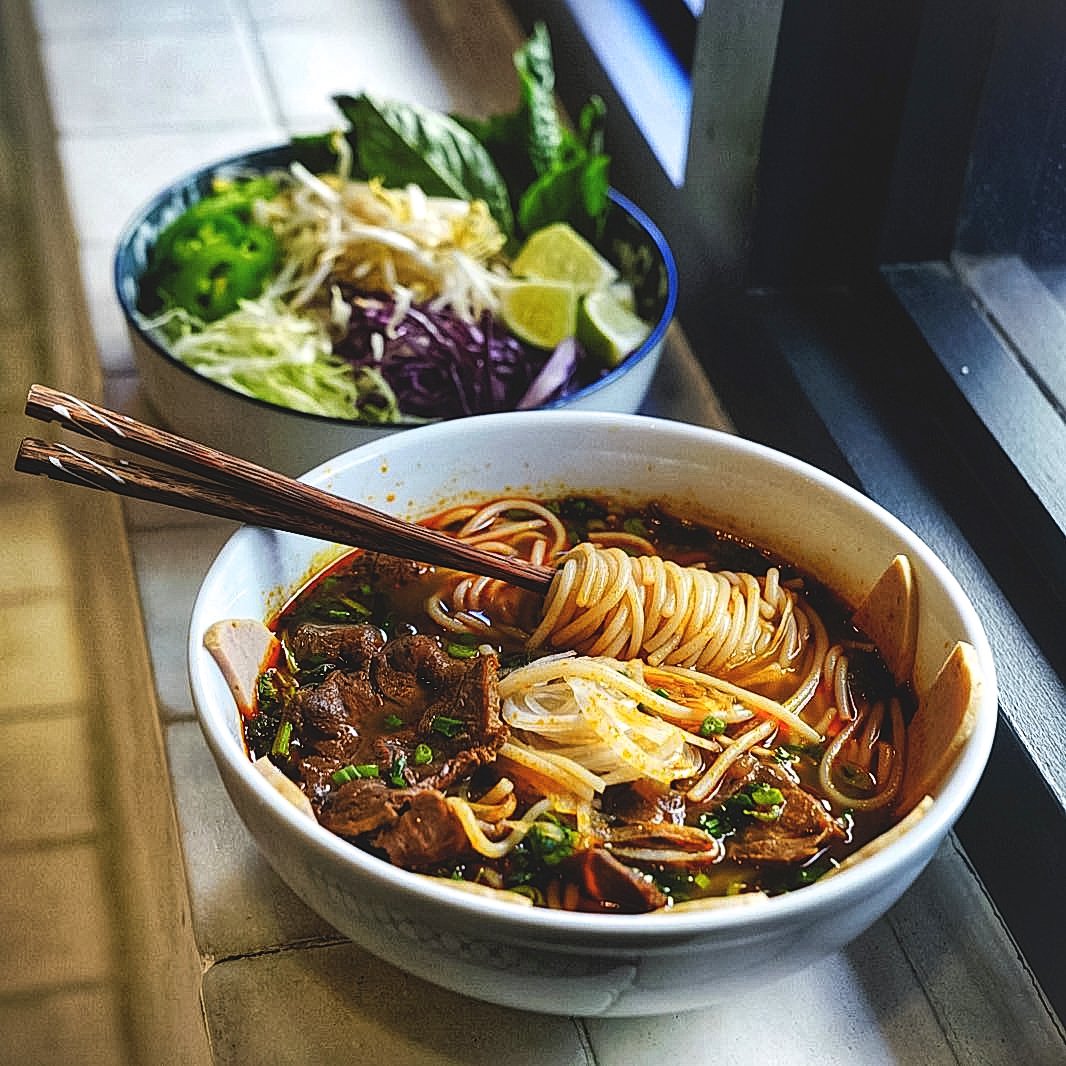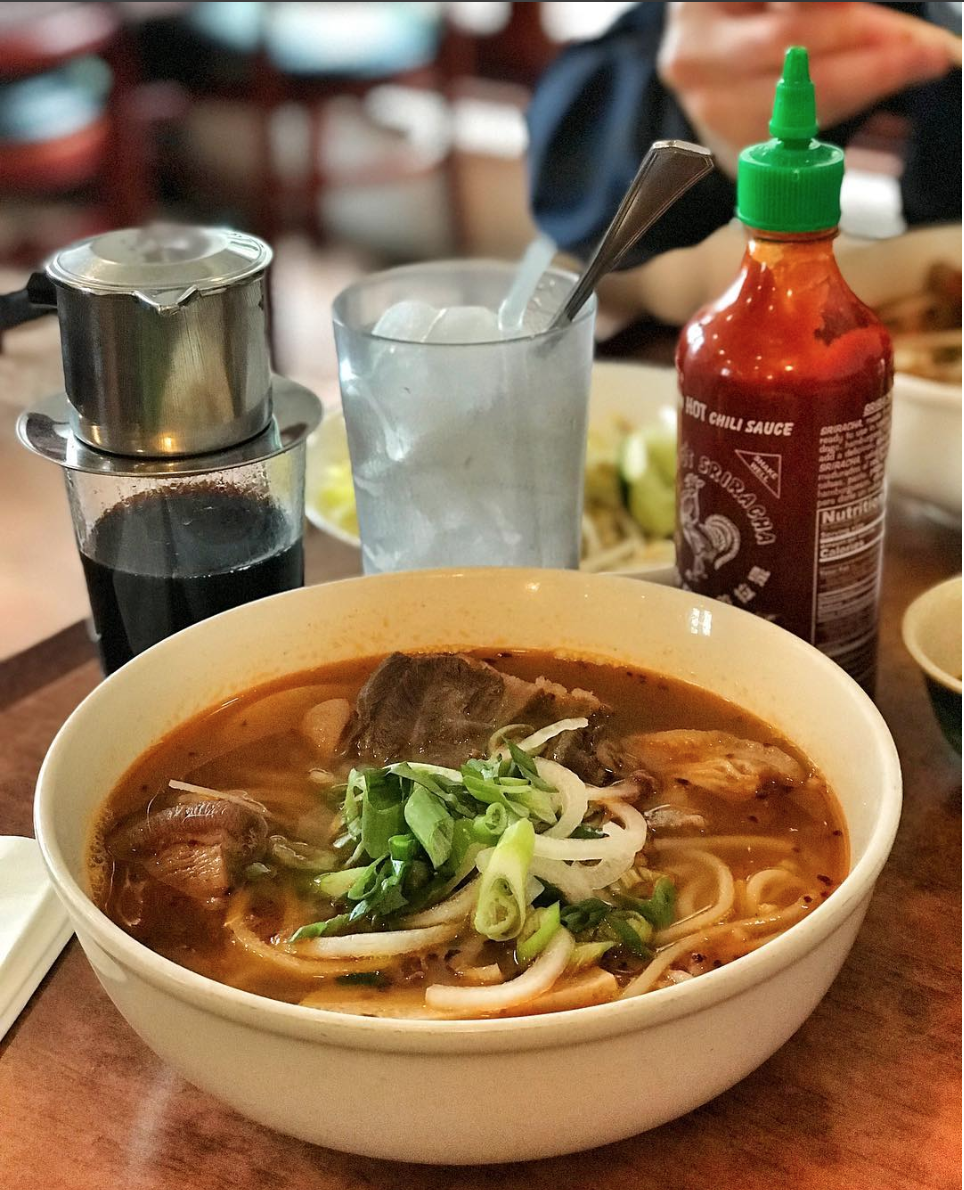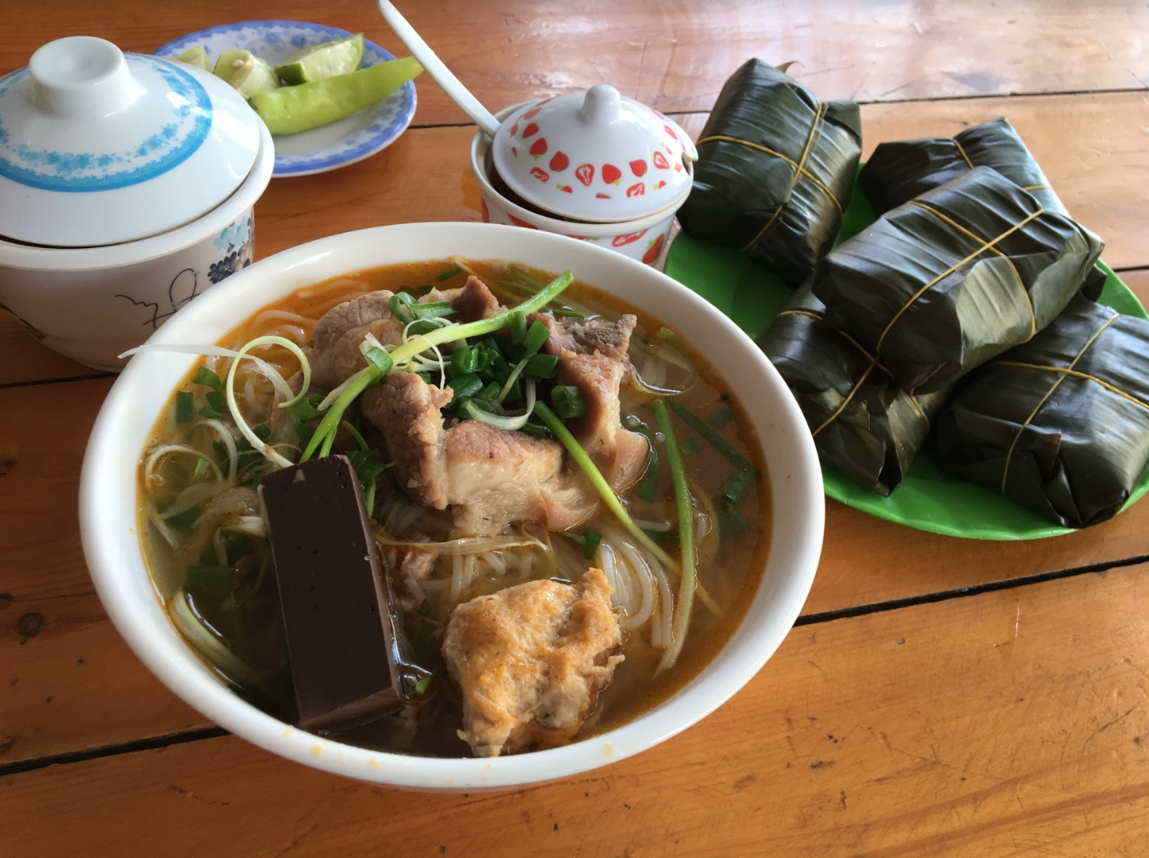Anthony Bourdain, a famous chef who accompanied former US President Barack Obama to eat the best bun cha in Hanoi, exclaimed that bun bo Hue “is the best soup in the world!” Let’s find out why bun bo Hue makes a strict food reviewer like Bourdain announce such a glowing compliment!
Contents
History & Origins of Bun Bo Hue
The legendary story of bun bo Hue began in the 16th century, when there lived a charming lady making rice noodles instead of farming out in the field. Unfortunately, her village had suffered a drought for three continuous years, and she was blamed for making God angry and therefore causing the drought. You might be wondering how she made God angry. Here’s an interesting fact: If you want to make rice noodles, you have to rub the rice grains with a lot of strength and effort into a hand mill. In the past, people believed that rice grain was the gem of God, which meant that rubbing rice grain offended Him. That’s the reason why she was forced to give up making rice noodles, or else she had to leave the village.

We should be grateful to this important lady because if she had chosen option one, we would never have had the chance to savor bun bo Hue – one of the best noodles on Earth today! After leaving the village, our lady experienced much hardship in finding an ideal destination to make rice noodles. And you know what, as Vietnamese people always believe that God never disappoints kind people, she found her new home at last! It was Van Cu, a beautiful village near the peaceful Bo River. This village, which is only about 30 minutes from Hue city, stands as a monument to the immortal soul of bun bo Hue.
Here is the Google Maps directions in case you’re eager to visit.
Evolution of Bun Bo Hue Over Time
In the early days, a bowl of bun bo Hue was super simple. Just rice noodles, stir-fried beef, and a simple broth made up the original ingredients of this dish. Through time, bun bo Hue has disruptively evolved and transformed into an amazingly delicious dish that can easily bring all the boys to the yard! A perfect bowl of bun bo Hue now includes its typical rice noodles, juicy pig shank, a cube of pig blood, lean beef, crab cake, and of course, the outstanding broth which makes this dish famous.
How to Cook Bun Bo Hue
Like other typical foods in Hue, the bun bo Hue cooking process is elaborate. First, the chef has to concentrate on cooking the broth, which we consider to be also the soul of the dish. The broth has an authentically juicy flavor made from pork and beef bones with herbs, but what makes it different is a special Vietnamese spice called “mam ruoc” or small shrimp paste. Unlike “mam tom” (another kind of shrimp paste) which smells a little pungent to the people who are not familiar with it, mam ruoc is strong but more delicate.
Because the smell is still a little bit strong, it needs to be neutralized with another ingredient. That’s when lemongrass appears! The difficulty in cooking bun bo Hue is balancing the amount of mam ruoc and lemongrass. If you put too much mam ruoc, your broth will smell strong and sharp. When there’s too much lemongrass, your broth will be bland. The chef must be skilfull enough to successfully develop the true taste of bun bo Hue.

In my opinion, although beef is the main protein of this dish (you can tell from its name), the most appealing ingredient of this food is the pig shank. The moment that you take a full bite, I believe that you’ll experience seventh heaven since it’s incredibly appetizing, sweet, juicy, flavorful, and addictive! And of course, we cannot underate the contribution of lean beef, pork cake, and pig blood. They make the dish so diverse, colorful, and mouth-watering.
You might have also noticed that bun bo Hue rice noodles are different from other noodles. It’s bigger, and because it’s made from rice flour and cassava flour, it looks clearer and tastes chewier. A complete bowl of bun bo Hue is replete with fresh herbs such as bean sprouts, sliced banana flowers, water spinach, lettuce, some other herbs, and also Hue saté chilli. And when a slice of lemon is squeezed into the dish, you know it’s the right time to savor!
Pro Tip: Sometimes, if you don’t tell the seller in advance, they will include pig foot (mong heo), which is not as tasty as pig shank (gio heo). Tell them that you want to eat pig shank (gio heo) because it’s the most delicious.
How to Eat Bun Bo Hue the Right Way
Although bun bo Hue is a popular dish in Vietnam, sadly many people don’t know how to enjoy it in the best way possible! Eating bun bo Hue the right way also means exploring Vietnamese cuisine the right way, so let’s take a look at what we need to prepare!

The first step is to simply look at it. Hey, don’t laugh! Sometimes I’m too rushed to eat and I don’t get to admire the food in front of me. Instead, observe this unique bowl of noodles for a few seconds, remember its appearance and smell. This dish should not just be a food but a new experience and nice memory of Vietnam! A bowl of bun bo Hue looks really tempting, the red and orange color of the broth, steamed meat, and flash of green fresh herbs are the beautiful colors of Vietnam too. The smell is so seductive that you can feel the curl of the scent of pig bones, lemongrass, shrimp paste, chili, and pepper right away!
So, what’s next?
Second, try the broth before you had spices and sauce! What do you taste? The real broth of bun bo Hue has a naturally sweet, salty, and spicy flavor of lemongrass combined with shrimp paste, chili, and ginger. Add lemon, fish sauce, chili, and herbs to your heart’s content and gobble it up. It’s a feast that has practically no cleanup!
Where to Eat Bun Bo Hue
There is no better bun bo Hue than that of its origin, Thua Thien-Hue Province, Vietnam. Moreover, if you try bun bo Hue in Thua Thien-Hue Province, you will witness typical cooking pots that are exclusive to Hue! Here are the top five bun bo Hue stores picked by locals:
Bun Bo Hue O Cuong Chu Diep
Location: 6 Tran Thuc Nhan, Hue city
Hours: 6:30 AM – 11 AM
Price range: 25,000 VND – 30,000 VND (1.2 USD – 1.4 USD)
Bun Bo Di Bup
Location: 68 Tran Quang Khai, Hue city
Hours: 6 AM – 9 AM
Price range: 20,000 VND – 30,000 VND (0.8 USD – 1.4 USD)
Bun Bo Ba Thuy
Location: 24 Nguyen Cong Tru, Hue city
Hours: 7 AM – 9 PM
Price range: 20,000 VND – 30,000 VND (0.8 USD – 1.4 USD)
Bun Bo Ba Nga
Location: 103 Xuan 68, Hue city
Hours: 5 PM – 11 PM
Price range: 20,000 VND – 30,000 VND (0.8 USD – 1.4 USD)
Bun Bo Ong Vong
Location: 5 Nguyen Du, Hue city
Hours: 3 PM – 6 PM
Price range: 20,000 VND – 45,000 VND (0.8 USD – 2 USD)
In case you don’t have enough time to stop by Hue City, these are the best bun bo Hue stores in Ho Chi Minh City:
A no-name Bun Bo Hue store on Hoang Sa street
Location: 725 Hoang Sa, District 3
Hours: 2:30 PM – 11 PM
Price range: 1.2 USD – 1.4 USD
Bun Bo Hue Xua
Location: 145 Cach Mang Thang 8, District 3
Hours: 24/7
Price range: 0.7 USD – 1.7 USD
Bun Bo Hue Hai Dang
Location: 48/10A Nguyen Bieu, District 5
Hours: 6 PM – 11 PM
Price range: 1.4 USD – 1.7 USD
Bun Bo Hue Co Nhu
Location: 287/41 Nguyen Dinh Chieu, District 3
Hours: 3 PM – 10 PM
Price range: 1.3 USD – 1.7 USD
A no-name Bun Bo Hue store on Pasteur street
Location: 63/12 Pasteur, District 1
Hours: 7:30 AM – 1:30 PM
Price range: 1.4 USD – 1.8 USD
How to Make Bun Bo Hue (Simple Recipe)
Bun bo Hue is not an easy dish to master. But don’t worry, because practice makes perfect, and this recipe will help you cook a delicious bun bo Hue meal.

Ingredients: For 3-4 servings (1kg = 2.2 lbs)
– 1kg of beef bone
– 400g beef brisket
– 200g crab cake
– 400g pig shank
– 6 stalks lemongrass
– ginger, sugar
– pig blood cubes (optional)
– 2 tbsp Vietnamese shrimp sauce (mam ruoc), saté
– bun bo Hue noodles (they’re thicker and bigger than normal Vietnamese noodles)
– herbs including bean sprouts, Thai basil, banana flower, lemon, chili
Instructions:
- Place the beef bones in a pot filled with enough water to cover the meat. Bring to a boil over high heat and cook for 5-10 minutes until the impurities rise to the top. Dump out the whole pot, rinse the bones well to wash off the scum
- Return the bones to the pot and fill with 3 liters of water. Also add the pig shank. At the same time, boil the beef brisket with ginger. The secret for boiling tender beef brisket is to gently use the chopsticks to stab the beef and see if it’s cooked or not.
- Add lemongrass, 1 peeled yellow onion, 1 tbsp salt, and 1 tbsp sugar into the pot. Bring to a boil over high heat, then lower to medium and simmer uncovered for 1 hour. Remember to skim off the scum. When the pork shank is cooked, remove the meat and soak in a bowl of cold water for 5 minutes to prevent it from turning dark. Then drain, let cool and slice thinly into bite-sized pieces. Meanwhile, continue to simmer the bones for 1-2 more hours.
- Dissolve Vietnamese fermented shrimp paste (mam ruoc Hue) in 1 cup of cold water. Let it sit for 10 minutes to settle the dregs. Fill a saucepan with 2 cups of water, add the shrimp paste liquid (discard the dregs at the bottom). Bring to a boil, then remove from heat and let it sit for 15 minutes, undisturbed, to settle the dregs again. Then extract the clear broth on top and add to the simmering pot. Discard the dregs. Adjust the flavor of the broth to your taste with salt, fish sauce, and chicken/pork stock.
- Put noodles, sliced beef, pork shank, and crab cake in a bowl. Also add boiled blood cubes (huyet). Ladle the broth over the noodles and garnish with the chopped spring onion, and paper-thin sliced onion. Serve with extra saté, bean sprouts, Thai basil, banana flower, lemon, and chili. Now, it’s all done and all you have to do is savor your cooking achievement!
Bun bo Hue is one of my all-time favorite dishes, it’s making it difficult to end my article here! Comment below for more dishes you want me to explore, I love food so consider me your guide. If you are in the planning stages of your trip, take a peek below at our other Hue articles and pop over to our main page.
Going Vegetarian in Hue: From Palace Dishes to Street Feasts
Hue Festival – Celebrate Culture & History in the Ancient Capital of Vietnam
